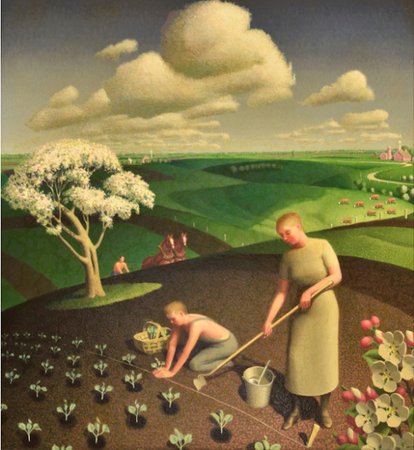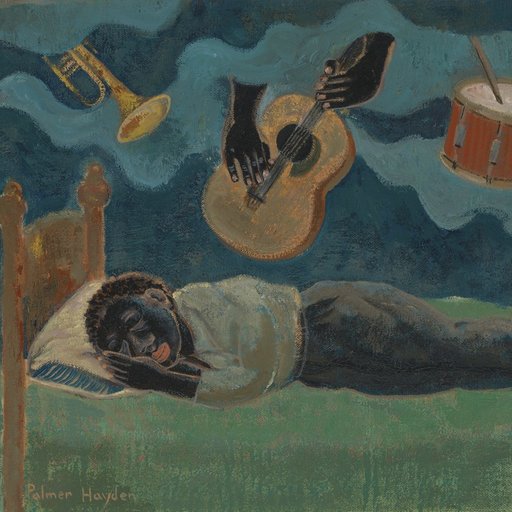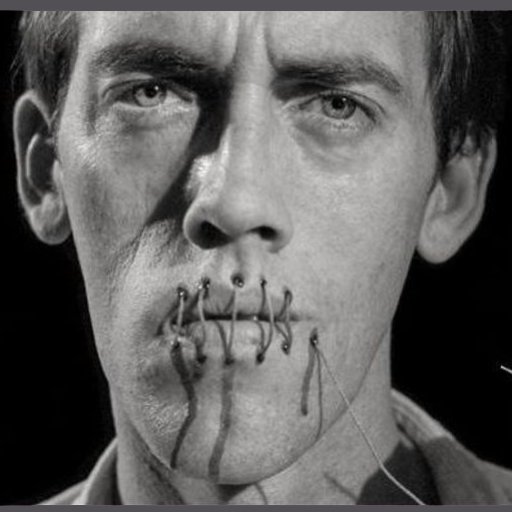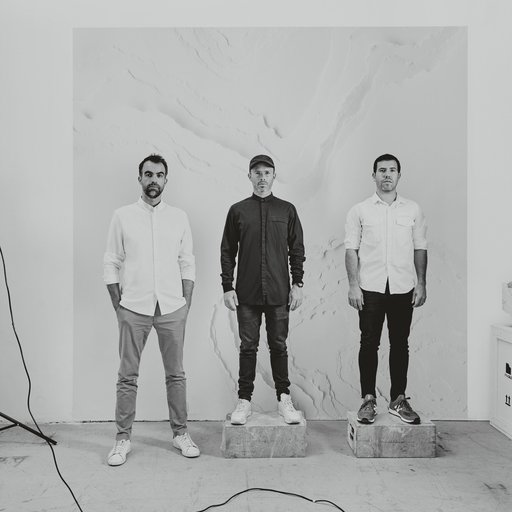Regionalism—which primarily existed in the American Midwest and South—began with the Great Depression and ended with World War II. Its artists rejected European modernism, industrialization, and cities. Instead, they depicted traditional rural life, hoping to recover (or invent) a dignified American identity during an economically and socially trying period. Visually, Regionalist art ranged from propagandistic social realism, melancholy paintings of (sub)urban melancholy—such as Edward Hopper, most famously—and the totally weird, such as Grant Wood, whose Whitney retrospective wrapped up in June. In addition to shame about being an artist, Wood was also a closeted homosexual, and hints of this inner turmoil arguably ruptures whatever Americana fantasy he wanted to project. In Spring in the Country (1941), a peaceful farming scene takes place beneath overcast skies, while in Spring Turning (1936), bucolic hills rock like unsteady ocean waves. But reading Wood as a hapless propagandist sells him short. As artist Sam McKinnis argued in his Artforum review of the Whitney show, “[Wood] isn’t purposefully misleading his constituents like some clueless, bad-faith operator, cursing his viewers into continued stupor as they live out their lives toiling the land under relentless brutality. He purposefully misleads his audience because lies are disguises and disguises are illusions and illusions are magical.” The text below is excerpted from Phaidon’s Art in Time.
Their idealized and reassuring depictions of the American Midwest and its rural way of life may have had little grounding in reality, but the country’s regionalists were nevertheless well received ruing a time of fading American optimism. As the Great Depression of the 1930s gave rise to growing political uncertainty, Regionalism would become the dominant art movement of the period. Its fierce nationalism and rejection of the corrupting influences of modernism and industrialization offered a sense of hope and promoted solidarity in a country still coming to terms with the increasingly harsh realities of urban life. Cities such as New York, saturated by foreign influences and run by “precious fairies,” as Thomas Hart Benton (1889-1975) described them, were seen as loathsome.
 Spring in the Country (1941), Grant Wood. Image via Whitney Museum
Spring in the Country (1941), Grant Wood. Image via Whitney Museum
Benton sought to promote an American made up of hard-working citizens who toiled on the plains of the Midwest. Alongside Grant Wood (1891-1942) and John Steuart Curry (1897-1946), he formed the “Regionalist Triumvirate,” and was one of the movement’s most vocal members. Together, they would lead the charge he said, for good honest images that were not foreign, elitist or “citified,” and which depicted American subjects. Benton even destroyed much of his earlier work to “get all of that modernist dirt out of my system,” before heading for Jefferson City, Missouri, where he completed a highly controversial mural to adorn the House Lounge under the auspices of the Federal Art Project. His figures, bulky and posturing divided audiences; one legislator in the state capital building remarked that you could not sit down for a game of cards without Jesse James about to jump on your back.
 Cradling the Wheat (1938), Thomas Hart Benton. Image via Curiator
Cradling the Wheat (1938), Thomas Hart Benton. Image via Curiator
The emphasis on narration was a recurring feature of Benton’s work. The Ballad of the Jealous Lover of Lone Green Valley, inspired by a well-known folk song, shows figures unnaturally contorted, almost grotesque, but the image itself is bold and brimming with movement, action and emotion. This bias towards dramatic storytelling is also seen in the work of John Steuart Curry, who was more preoccupied with the struggles of the archetypical rural family against violent forces of nature. Tornado Over Kansas depicts the patriarchal, square-jawed father leading the family to safety and standing firm amidst the twisting structures of the homestead. Curry had previously been employed as an illustrator and offers little in the way of ambiguity.
 Spring Turning (1936), Grant Wood. Image via Reynolda House: Museum of American Art
Spring Turning (1936), Grant Wood. Image via Reynolda House: Museum of American Art
The work of Grant Wood, who often told journalists he returned to Iowa because “I realized my best ideas came to me whilst I was milking cows,” is far more elusive. Even the title of his masterpiece, American Gothic, is ambiguous. While it seems to refer to the building behind the main figures, it also has connotations with Edgar Allan Poe and the prejudice prevalent in the big American cities towards supposedly inbred country folk. The piece could be read as both sincere and satirical in its portrayal of nineteenth century Midwestern values. Edward Hopper (1882-1967) is similarly perplexing in Nighthawks. Like Wood, Hopper contrasts to earlier Regionalists such as Benton, whose work he thought “caricatured America.” Yet Nighthawks does not offer a hopeful view of the American heartland, but a melancholy vision of the urban isolation and incipient violence that become more visible and prevalent during the Depression.
[related-works-module]
RELATED ARTICLES:
What was the Harlem Renaissance? A "Flowering of Black Creativity"
How Did Feminist Art Begin? A Brief History of Women Rejecting the Patriarchy in the Art World
Artists Don't Get Mad at Museums, They Get Even: How to Understand Institutional Critique
























